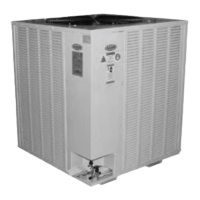the hot gas line. Field piping between the
condensing unit and the air handler is
required.
The line delivers the hot discharge gas to the
reheat coil and/or the hot gas bypass valve,
so it is sized as a discharge line.
Discharge lines should be sized to ensure
adequate velocity of refrigerant to ensure oil
return, avoid excessive noise associated with
velocities that are too high, and to minimize
efficiency losses associated with friction.
Pitch the hot gas line in the direction of flow
for oil return.
When installing hot gas reheat risers, an oil
drip line must be provided at the lowest
point in the system. The oil drip line must be
vertical, its diameter should be the same as
the diameter of the riser, and it should be 1
foot long. Run a drip line, using 1/8 inch
capillary tube, 10 feet in length, from the oil
drip line to the suction line. Connect the oil
return line below the sight glass and 1 inch
above the bottom of the oil drip line.
Insulate the entire length of the hot gas line
with a minimum 1 inch thick Armaflex
insulation.
Hot Gas Reheat Guidelines
Maintain velocities below a maximum of
4,000 fpm. A general minimum velocity
guideline is 900 fpm.
Predetermined Line Sizes
To aid in line sizing and selection, AAON
has predetermined line sizes for the liquid,
suction, and hot gas lines in comfort cooling
applications.
In order to generate this information, the
following cycle assumptions are made:
Saturated suction temperature = 50°F,
Saturated condensing temperature = 125°F,
Sub-cooling = 10°F, Superheat = 15°F.
The liquid lines have been chosen to
maintain velocities between 100 and 350
fpm. The suction line diameters are selected
to limit velocities to a 4,000 fpm maximum,
while a minimum velocity restriction is
imposed by the ability to entrain oil up
vertical suction risers (ASHRAE Handbook
- Refrigeration).
Acceptable pressure loss criteria are applied
to each of the lines: The total equivalent
length of the liquid line available is
determined such that 3°F of liquid sub-
cooling remain at the TXV. This includes
the pressure losses in horizontal and vertical
sections, accessories, elbows, etc.
Recall that the available sub-cooling for the
cycle is assumed as 10°F. To maintain at
least 3°F sub-cooling as a factor of safety to
avoid flashing at the TXV, we consider a
maximum pressure loss equivalent to a 7°F
change in saturation temperature. Pressure
losses in the suction line are not to exceed
2°F.
When to Use Predetermined Line Sizing
The line sizes presented are not the only
acceptable pipe diameters, they are however
appropriate for general comfort cooling
applications, and satisfy common job
requirements. Examine the conditions,
assumptions, and constraints used in the
generation of the predetermined pipe
diameters to ensure that this method is
applicable to a particular case. Do not
assume that these line sizes are appropriate
for every case. Consult ASHRAE
Handbook – Refrigeration for generally
accepted system piping practices.

